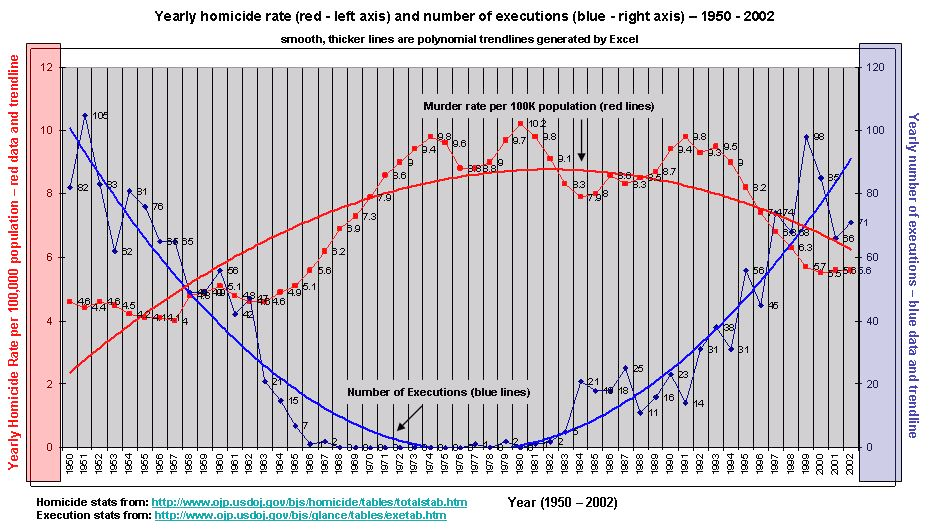A Case for the Death Penalty Paper
Reasons: The author provides various reasons in favor of the death penalty such as the chart saying that when there are more executions there are fewer murders. According to the death penalty information center over the past 20 years, there are 48%-101% more murders in states that have the death penalty than states that don’t. The author also reasons that the death penalty process is lengthy and that they do not kill innocent people. Since 1976 there have been 1532 people have been executed as a result of the death penalty and there is no way to say how many of them may be innocent as once they have been executed the case is over, and their life can no longer be saved. The DPIC also provides a list of 20 cases that consist of strong and compelling evidence of people who were wrongfully executed. Lastly, the author states that in 2010 56 police officers were killed line of duty by “people who no doubt have killed before.” In 2010 there are 69 alleged suspects in the killing of the 56 police officers, and of these 69 57% had a criminal record. That does not mean they have killed or have violent offenses it just means they have been arrested before. A Case for the Death Penalty Paper.
ORDER A PLAGIARISM-FREE PAPER NOW
example of reply
Hi Tyler,
I really enjoyed reading your response and seeing statistics you also provided. It was interesting to learn the high percentages of murders that have occurred in states where the death penalty is used whereas in other states where they do not. I agree the author provided several reasons in favor of the death penalty. The chart used to show the data was useful in quickly seeing how murder rate escalated when number of executions decreased. In a portion of his argument, he also mentions how the innocent life taken had no right to appeal and went onto mention how “it is a fallacy to argue that the death penalty should be abolished because an innocent person might die.” In an article I came across from the DPIC, it indicates a prisoner housed in a federal penitentiary has a right to one appeal as a “matter of right”. After an appeal at the court where the person was tried for the crime, they can also seek appeals and overturn the sentence based on whether sentence was constitutional and whether any new laws have been instituted. Appeals can and should also be filed when and if new evidence is presented that provides a substantial and clear proof of innocence.
Thanks again for great and informative response!
2.The issue in the death penalty article can be defined as a prescriptive issue as it raises questions on what is right or wrong, or good or bad. I believe the identified issue in the article is the questioning of use of applying capital punishment in crimes for a person convicted of committing such crime as murder. The author argues the point that death penalty should be supported, and the provides reasoning for support of the topic using phrases such as, “fighting fire with fire” and “evidence is clear” indicating “when executions went down, murders went up.” A Case for the Death Penalty Paper. Additionally, noting “once execution was resumed in 1977” the author indicated murder rate went down providing additional reasoning behind his statement of support of the death penalty. I believe the conclusion in the article was in the initial opening of the article where the message is clearly stated in that the individual died as a result of his conviction 19 years earlier for murder.
) Troy Davis, 42, died at 11:08 p.m. according to the Georgia Department of Corrections. (2) His death by lethal injection came 19 years after he was convicted by a jury of his peers for the brutal murder of off duty police officer Mark MacPhail.
(3) Moments before his execution, Davis reportedly told the family of Mr. MacPail, “I’m not the one who personally killed your son, your father, your brother. I am innocent.” (4) Mr. Davis’ newfound reverence for life, stems in no small part, from the fact that he was about to lose his own. (5) Life is precious and the death penalty just reaffirms that fact.
(6) I support the death penalty for cop killers and heinous crimes of murder. (7) The death penalty is a deterrent. (8) Without a doubt, Mr. Davis will never kill again. (9) We don’t have to like the death penalty in order to support it. (10) We must fight fire with fire. (11) If someone comes down with cancer, it may be necessary to take radical steps to cure the cancer: radical surgery, radiation, and chemotherapy. (12) The disease in this case is injustice. (13) Should this cop killer be given clemency? (14) We may not like the death penalty, but it must be available for such heinous crimes; otherwise, we are giving criminals, like Mr. Davis, a license to kill.
(15) The evidence is clear. (16) When executions went down, the number of murders went up. (17) Looking at the data from 1950-2002, the murder rate went from 4.6 per 100,000 population in 1951 to 10.2 per 100,000 population in 1980, as executions went to zero during the period the Supreme Court declared capital punishment unconstitutional. (18) Execution resumed in 1977. (19) As you can see, the murder rate once again declined (see chart below).

(20) Opponents of the death penalty often make the argument that we might kill an innocent person. (21) Mark MacPail was an innocent person who was executed by Mr. Davis. (22) He received no appeals to the Supreme Court; no appeals for clemency. (23) Mr. Davis killed in cold blood. (24) It is fallacy to argue that the death penalty should be abolished because an innocent person might die. (25) Innocent persons are dying all the time; however, only the murderers have the chance to appeal their sentence. A Case for the Death Penalty Paper.
ORDER A PLAGIARISM-FREE PAPER NOW
(26) In 2010, fifty-six police officers were killed in the line of duty in the US. (27)
No doubt by someone who had murdered before. (28) Even life in prison does not guarantee that they will not kill again. (29) All too often, these individuals kill again in prison.
(30) Life without parole does not always mean life without parole. (31) California is about to release teen murderers, including cop killers, who were sentenced to life without parole for their crimes.
(32) When we lower the penalty for murder, it diminishes regard for the value of the victim’s life. (33) Support for the death penalty comes from a surprising group of people—Kant, Locke, Hobbes, Rousseau, Montesquieu, and Mill agreed that natural law properly authorizes the State to take life in order to administer justice. (34) Washington, Jefferson, and Franklin endorsed it. Abraham Lincoln authorized executions for deserters in wartime. (35) Alexis de Tocqueville, the author of Democracy in America, believed that the death penalty was essential to the support of social order. (36) The United States Constitution condemns cruel and inhuman punishment, but does not condemn capital punishment.
(37) Rick Perry stated that,” Texas has a very thoughtful, lengthy, and clear process, which ensures everyone a fair hearing, so there is no need to lose sleep over the possibility of executing an innocent person”. (38) The appeals process is indeed lengthy. (39) Mr. Davis had 19 years of appeals and the Supreme Court reaffirmed his guilt. (40) Finally justice has been served. A Case for the Death Penalty Paper.

